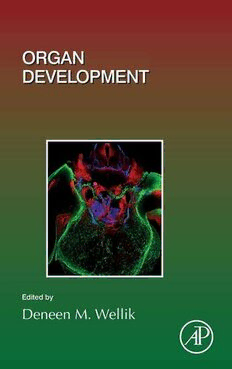
Organ Development PDF
Preview Organ Development
CURRENT TOPICS IN DEVELOPMENTAL BIOLOGY “Ameeting-groundforcriticalreviewanddiscussionofdevelopmentalprocesses” A.A.MosconaandAlbertoMonroy(Volume1,1966) SERIES EDITOR Paul M. Wassarman DepartmentofCell,DevelopmentalandRegenerativeBiology IcahnSchoolofMedicineatMountSinai NewYork,NY,USA CURRENT ADVISORY BOARD Blanche Capel Susan Mango Wolfgang Driever Philippe Soriano Denis Duboule Cliff Tabin Anne Ephrussi MagdalenaZernicka-Goetz FOUNDING EDITORS A.A. Moscona and Alberto Monroy FOUNDING ADVISORY BOARD Vincent G. Allfrey Dame Honor B.Fell Jean Brachet John C. Kendrew Seymour S. Cohen S.Spiegelman Bernard D.Davis Hewson W. Swift James D. Ebert E.N.Willmer Mac V. Edds, Jr. Etienne Wolff AcademicPressisanimprintofElsevier 50HampshireStreet,5thFloor,Cambridge,MA02139,UnitedStates 525BStreet,Suite1650,SanDiego,CA92101,UnitedStates TheBoulevard,LangfordLane,Kidlington,OxfordOX51GB,UnitedKingdom 125LondonWall,London,EC2Y5AS,UnitedKingdom Firstedition2019 Copyright©2019ElsevierInc.Allrightsreserved. Nopartofthispublicationmaybereproducedortransmittedinanyformorbyanymeans, electronicormechanical,includingphotocopying,recording,oranyinformationstorageand retrievalsystem,withoutpermissioninwritingfromthepublisher.Detailsonhowtoseek permission,furtherinformationaboutthePublisher’spermissionspoliciesandour arrangementswithorganizationssuchastheCopyrightClearanceCenterandtheCopyright LicensingAgency,canbefoundatourwebsite:www.elsevier.com/permissions. Thisbookandtheindividualcontributionscontainedinitareprotectedundercopyrightby thePublisher(otherthanasmaybenotedherein). Notices Knowledgeandbestpracticeinthisfieldareconstantlychanging.Asnewresearchand experiencebroadenourunderstanding,changesinresearchmethods,professionalpractices, ormedicaltreatmentmaybecomenecessary. Practitionersandresearchersmustalwaysrelyontheirownexperienceandknowledgein evaluatingandusinganyinformation,methods,compounds,orexperimentsdescribed herein.Inusingsuchinformationormethodstheyshouldbemindfuloftheirownsafetyand thesafetyofothers,includingpartiesforwhomtheyhaveaprofessionalresponsibility. Tothefullestextentofthelaw,neitherthePublishernortheauthors,contributors,oreditors, assumeanyliabilityforanyinjuryand/ordamagetopersonsorpropertyasamatterof productsliability,negligenceorotherwise,orfromanyuseoroperationofanymethods, products,instructions,orideascontainedinthematerialherein. ISBN:978-0-12-810489-7 ISSN:0070-2153 ForinformationonallAcademicPresspublications visitourwebsiteathttps://www.elsevier.com/books-and-journals Publisher:ZoeKruze AcquisitionEditor:FionaPattison EditorialProjectManager:ShellieBryant ProductionProjectManager:DennyMansingh CoverDesigner:MilesHitchen TypesetbySPiGlobal,India Contributors HaleyAbbott DepartmentofCellandDevelopmentalBiology,UniversityofMichiganMedicalSchool, AnnArbor,MI,UnitedStates MadelineG.Andrews DepartmentofNeurobiology;NeuroscienceGraduateProgram,UniversityofCalifornia, LosAngeles,CA,UnitedStates NadeanL.Brown DepartmentofCellBiology&HumanAnatomy,UniversityofCaliforniaDavisSchoolof Medicine,Davis,CA,UnitedStates SamanthaJ.Butler DepartmentofNeurobiology;EliandEdytheBroadCenterofRegenerativeMedicineand StemCellResearch,UniversityofCalifornia,LosAngeles,CA,UnitedStates TerenceD.Capellini DepartmentofHumanEvolutionaryBiology,HarvardUniversity;BroadInstituteof HarvardandMIT,Cambridge,MA,UnitedStates OndineCleaver DepartmentofMolecularBiologyandCenterforRegenerativeScienceandMedicine, UniversityofTexasSouthwesternMedicalCenter,Dallas,TX,UnitedStates TaylorCool InstitutefortheBiologyofStemCells,PrograminMolecular,Cell,andDevelopmental Biology,UniversityofCalifornia,SantaCruz,SantaCruz,CA,UnitedStates CorinnaCozzitorto MaxDelbru€ckCenterforMolecularMedicine(MDC),Berlin,Germany EdwardDaniel DepartmentofMolecularBiologyandCenterforRegenerativeScienceandMedicine, UniversityofTexasSouthwesternMedicalCenter,Dallas,TX,UnitedStates E.CamillaForsberg InstitutefortheBiologyofStemCells,DepartmentofBiomolecularEngineering,University ofCalifornia,SantaCruz,SantaCruz,CA,UnitedStates AnkurGarg DepartmentofPediatrics,UniversityofCalifornia,SanDiego,LaJolla,CA,UnitedStates DeborahL.Gumucio UniversityofMichigan,CellandDevelopmentalBiologyDepartment,AnnArbor,MI, UnitedStates SaherSueHammoud DepartmentofHumanGenetics;DepartmentofObstetricsandGynecology;Departmentof Urology,UniversityofMichiganMedicalSchool,AnnArbor,MI,UnitedStates ix x Contributors StaceyS.Huppert DivisionofGastroenterology,Hepatology&Nutrition,CincinnatiChildren’sHospital MedicalCenter;DepartmentofPediatrics,UniversityofCincinnatiCollegeofMedicine, Cincinnati,OH,UnitedStates MakikoIwafuchi-Doi DepartmentofPediatrics,UniversityofCincinnatiCollegeofMedicine;Divisionof DevelopmentalBiology,CincinnatiChildren’sHospitalMedicalCenter,Cincinnati,OH, UnitedStates GabrielleKardon DepartmentofHumanGenetics,UniversityofUtah,SaltLakeCity,UT,UnitedStates JenniferKong DepartmentofNeurobiology;NeuroscienceGraduateProgram,UniversityofCalifornia, LosAngeles,CA,UnitedStates HaileyLarose DepartmentofHumanGenetics,UniversityofMichiganMedicalSchool,AnnArbor,MI, UnitedStates LeiLei DepartmentofCellandDevelopmentalBiology;DepartmentofBiomedicalEngineering, UniversityofMichiganMedicalSchool,AnnArbor,MI,UnitedStates GabrielManske DepartmentofHumanGenetics,UniversityofMichiganMedicalSchool,AnnArbor,MI, UnitedStates JoelB.Miesfeld DepartmentofCellBiology&HumanAnatomy,UniversityofCaliforniaDavisSchoolof Medicine,Davis,CA,UnitedStates BennettG.Novitch DepartmentofNeurobiology;EliandEdytheBroadCenterofRegenerativeMedicineand StemCellResearch,UniversityofCalifornia,LosAngeles,CA,UnitedStates KyrielM.Pineault DepartmentofCell&RegenerativeBiology,UniversityofWisconsin,Madison,WI, UnitedStates ElizabethM.Sefton DepartmentofHumanGenetics,UniversityofUtah,SaltLakeCity,UT,UnitedStates LiciaSelleri PrograminCraniofacialBiology,DepartmentofOrofacialSciences;PrograminCraniofacial Biology,DepartmentofAnatomy,EliandEdytheBroadCenterofRegenerationMedicine &StemCellResearch,UniversityofCalifornia,InstituteofHumanGenetics,SanFrancisco, CA,UnitedStates AdrienneNiederriterShami DepartmentofHumanGenetics,UniversityofMichiganMedicalSchool,AnnArbor,MI, UnitedStates Contributors xi PragyaSidhwani DivisionofBiologicalSciences,UniversityofCalifornia,SanDiego,CA,UnitedStates JaneY.Song PrograminCellandMolecularBiologyProgram,UniversityofMichigan,AnnArbor,MI, UnitedStates FrancescaM.Spagnoli MaxDelbru€ckCenterforMolecularMedicine(MDC),Berlin,Germany;CentreforStem CellandRegenerativeMedicine,King’sCollegeLondon,London,UnitedKingdom PengfeiSui DepartmentofPediatrics,UniversityofCalifornia,SanDiego,LaJolla,CA,UnitedStates XinSun DepartmentofPediatrics;DepartmentofBiologicalSciences,UniversityofCalifornia,San Diego,LaJolla,CA,UnitedStates JamieM.Verheyden DepartmentofPediatrics,UniversityofCalifornia,SanDiego,LaJolla,CA,UnitedStates KatherineD.Walton UniversityofMichigan,CellandDevelopmentalBiologyDepartment,AnnArbor,MI, UnitedStates ShaWang UniversityofMichigan,CellandDevelopmentalBiologyDepartment,AnnArbor,MI, UnitedStates DeneenM.Wellik DepartmentofCell&RegenerativeBiology,UniversityofWisconsin,Madison,WI, UnitedStates DeborahYelon DivisionofBiologicalSciences,UniversityofCalifornia,SanDiego,CA,UnitedStates LisaR.Young DivisionofPulmonaryMedicine,CenterforChildhoodLungResearch,Departmentof Pediatrics,VanderbiltUniversityMedicalCenter,Nashville,TN,UnitedStates MarielYoung DepartmentofHumanEvolutionaryBiology,HarvardUniversity,Cambridge,MA, UnitedStates Preface Organogenesisisoneofthemostfascinatingaspectsofembryonicdevelop- ment.Itisthegenerationofthesestructuresthatinitiateaftertheembryohas created germ layers and begun segmenting into spatially distinct regions that permit an organism to think, see, breathe, eat, move, and reproduce. A review how organs initiate, grow, and maintain and repair themselves formthebasisofthisvolume.Whileitisnotpossibletobecomprehensive, thisvolumeincludesareviewoftheformationofendodermalorgans,such as the lung (Dr. Xin Sun, PhD and colleagues), gut (Katherine Walton, PhD),pancreas(FrancescaSpagnoli,MD,PhD)andliver(StaceyHuppert, PhD). Mesodermal organs reviewed include the hematopoietic system (Camilla Forsberg, PhD), muscle and muscle connective tissue (Gabrielle Kardon, PhD), the vascular system (Ondine Cleaver, PhD), the pelvis andscapula(LiciaSelleri,MD,PhDandTerranceCapellini,PhD),theheart (Deborah Yelon, PhD), and the limb musculoskeletal system (Deneen Wellik, PhD). The ectodermal organs are represented by reviews of the spinal cord (Samantha Butler, PhD and Bennett Novitch, PhD), the eye (NadeanBrown,PhD),andgermcells(SueHammoud,PhDandLei,PhD). It is of note that all of the reviews do not focus solely on the organo- genesisprocessesassociatedwithembryonicdevelopment,nordotheyfocus solely on embryology and genetics. While a vast amount of our current knowledge continues to be impacted by our ability to manipulate both thegenomeandtheembryoitself, thefieldhasexpandedto includegeno- mics,systemsbiology,andbiophysical,structuralandbiomechanicalstudies into the existing body of knowledge. Further, continued work in the field hasbeguntorevealthatorganogenesis,andthestudyofthisbasicknowledge is highly relevant to postnatal and adult organ biology and is critical for understanding organ maintenance, organ response to injury and disease, andtheorgan’sability(orinability)tohealandregenerateitselfafterinsults. Many of the same factors and pathways that are critical for the initial developmentandearlygrowthofourorganscontinuetoplayfundamental roles throughout life. Further, these original pathways and processes are additionally influenced by new cell types (i.e., the microbiome), new molecularfactors,andtheimmunesystem.Currentworkinthefieldisusing a combination of basic knowledge from many fields to begin to dissect the more complex interplay that impact adult organ systems in health and disease. xiii xiv Preface A Note About the Authors The thirteen chapters included in this volume are contributed by leaders in their respective fields, scientists that promote biomedical science and education through their own outstanding research programs, peer- review of grants and manuscripts, administrative service, teaching, and outreach at their own institutions and around the world. Notably, at least one of the corresponding authors for each chapter is female, highlighting the broad and essential contributions of female scientists to the fields of organogenesis, and serving as a reminder of the gender-neutral power of genetics to reveal fundamental scientific truths. DENEEN M. WELLIK, PHD Professor and Chair Department of Cell & Regenerative Biology University of Wisconsin-Madison Madison, WI, United States Stacey S. Xin Sun, PhD, Katherine NadeanBrown, E. Camilla Huppert,PhD., Professor,Dept. Walton,PhD., PhD, Professor, Forsberg, Associate of Pediatrics, Assistant Cell Biol. & PhD, Professor,Dept. UCSD Professor, Human Anat., Professor, of Pediatrics, Dept. Cell & UC Davis Biomolecular Cinncinnati Devel.Biol., Engineering, Children’s Michigan UCSanta Medicine Cruz CHAPTER ONE Chasing Mavericks: The quest for defining developmental waves of hematopoiesis Taylor Coola, E. Camilla Forsbergb,* aInstitutefortheBiologyofStemCells,PrograminMolecular,Cell,andDevelopmentalBiology,University ofCalifornia,SantaCruz,SantaCruz,CA,UnitedStates bInstitutefortheBiologyofStemCells,DepartmentofBiomolecularEngineering,UniversityofCalifornia, SantaCruz,SantaCruz,CA,UnitedStates *Correspondingauthor:e-mailaddress:[email protected] Contents 1. Introduction 2 2. HSCemergence:Where,when,andhow? 4 2.1 CellularoriginsofHSCs:Hemangioblastversushemogenicendothelium 4 2.2 AreHSCsspecifiedmultipletimesindistinctlocations? 7 3. MolecularregulationofHSCspecification 9 3.1 WhatarethemoleculardriversofHSCspecificationandmaintenance? 9 4. PhenotypicandfunctionalheterogeneitywithintheHSPCpool 13 4.1 Extensivetranscriptomeheterogeneityofcellpopulations 13 4.2 Functionalheterogeneityofhematopoieticprogenitorpopulations 14 4.3 DoallHSCspersist? 15 5. Purposeofdevelopmentalwaves 17 5.1 Immunesystemlayering 17 6. Conclusionandfuturedirections 19 Acknowledgments 20 Authorcontributions 20 Competinginterests 20 References 20 Furtherreading 29 Abstract Hematopoiesisistheprocessbywhichmaturebloodandimmunecellsareproduced from hematopoietic stem and progenitor cells (HSCs and HSPCs). The last several decadesofresearchhaveshedlightontheoriginofHSCs,aswellastheheterogeneous pools offetalprogenitors thatcontribute to lifelonghematopoiesis. Theoverarching concept that hematopoiesis occurs in dynamic, overlapping waves throughout development,witheachwavecontributingtobothcontinuousanddevelopmentally limited cell types, has been solidified over the years. However, recent advances in CurrentTopicsinDevelopmentalBiology,Volume132 #2019ElsevierInc. 1 ISSN0070-2153 Allrightsreserved. https://doi.org/10.1016/bs.ctdb.2019.01.001 2 TaylorCoolandE.CamillaForsberg ourabilitytotracktheproductionofhematopoieticcellsinvivohavechallengedseveral long-helddogmasontheoriginandpersistenceofdistincthematopoieticcelltypes. In this review, we highlight emerging concepts in hematopoietic development and identifyunansweredquestions. 1. Introduction Hematopoietic stem cells (HSCs) are blood stem cells capable of self-renewal and differentiation into lineage-restricted progenitor cells that ultimately make mature cell types with highly specialized functions. HSCs were first described in the 1960s as cells capable of giving rise to spleen colonies containing clonally multipotent cells (Becker, McCulloch, & Till,1963;Wu,Till,Siminovitch,&McCulloch,1968).Thesestudieslaid thegroundworkforourinitialunderstandingofbloodstemcellsanddefined them as cells with combined self-renewal and multilineage hematopoietic differentiation capability upon transplantation into a suitable host. Subse- quently, Spangrude et al. demonstrated that 30 HSCs were sufficient to rescue half a population of lethally irradiated mice, indicating the potent reconstitution capacity of these cells (Spangrude, Heimfeld, & Weissman, 1988). Since then, thefield of molecular and cellular biology has advanced rapidly,allowingforextremelysensitivedetectionofdonor-derivedcellsto assesstheclonalcapacityofdistinctsubsetsofhematopoieticstemandpro- genitor cells (HSPCs). WhiletransplantationofHSPCsintoconditionedhostshaslongbeenthe “gold standard” in the field, in situ fate mapping, barcoding, and RNA sequencing (RNA-seq) have become increasingly common to interrogate HSCidentity andfunction. There arepros and cons to each ofthese tech- niques. Transplantation assays test the inherent potential of stem and pro- genitor cells to produce different cell types. However, the conditioning regimenstypicallyusedtoensurerobustreconstitutionmayaffecttheline- agecapacityand/orpreferenceoftheincomingcellsaswellastheclearance ofresidentcelltypes,thusalteringtheperceivedpotentialofthetransplanted cell.AlthoughreconstitutionassaysremainanessentialtooltoassessHSPC invivolineagepotentialandthetherapeuticpotentialofcellsubpopulations for regenerative medicine, HSPC transplantation might not reflect the cell ontogenyofnormalhematopoiesis.Fatemappingusingpermanentgenetic marking allows for tracking of HSPC differentiation in situ without disrupting normal hematopoiesis. Yet, it is difficult to reliably pinpoint
